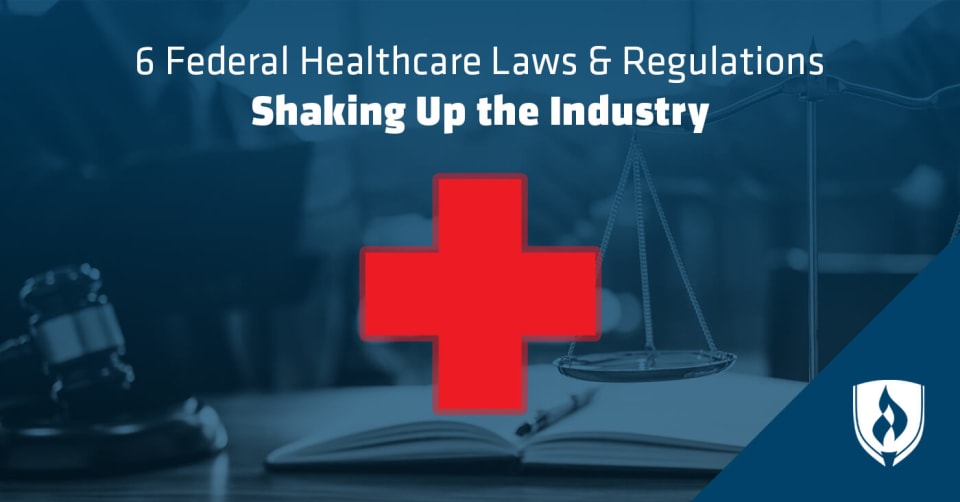
Healthcare is a rewarding career field, but it can also be intimidating. Not only do you need to know important medical information inside and out, healthcare workers are also responsible for keeping up with complicated laws and regulations.
Federal healthcare laws are constantly changing. With everything else you have on your plate, it can feel like keeping up with federal healthcare regulations isn’t worth it. But all healthcare professionals should stay up-to-date on healthcare laws — even if you aren’t in the workforce yet.
“Becoming familiar with healthcare laws before you’re faced with a real-world challenge that requires that knowledge will go a long way,” says Michael Z. Stahl, Sr. VP of HealthMarkets. “It also lowers your chances of inadvertently violating the law once you do join the workforce.”
Federal healthcare laws can be confusing, but it’s essential for every healthcare professional to be familiar with them. We’re demystifying six healthcare regulations you need to know. Thanks to this breakdown from our experts, you’ll be prepared to act within the law in the healthcare field.
6 federal healthcare laws healthcare professionals should know
You may have joined the healthcare field because you want to make a difference in patient’s lives, but federal healthcare laws can also be a big part of your daily work. “Healthcare compliance is a major concern, and students should be aware and prepared for the challenges they will face when they enter the workforce,” says Denise VanFleet, health information management program coordinator at Rasmussen College.
Enter your healthcare career with all the knowledge you need about these six important federal healthcare laws.
1. Concurrent and retrospective review
Insurance companies use these two types of utilization review to verify that a patient actually requires the medical care they’re receiving. Concurrent reviews are performed while a patient is still hospitalized, while retrospective reviews take place after treatment is finished and the patient has been discharged.
If a reviewer finds that treatment isn’t necessary, the insurance company may “take back payment for a previously paid claim or deny payment on previously provided healthcare services,” says VanFleet. Medical procedures that are uncovered by insurance can be a weighty expense for patients, so healthcare workers need to keep these reviews in mind when providing care.
2. Medical necessity
Medical necessity states that any healthcare services a patient receives must meet minimum medical necessity standards before insurance will make any payments. Much like with the utilization reviews above, insurance companies want to make sure treatments are actually required before they issue payouts.
Medical necessity may seem simple, but it’s an important regulation for healthcare providers to know. “If healthcare workers are providing cases which are not necessary, they are not reimbursable and are therefore fraud,” says attorney James Young. Insurance fraud is definitely something you’ll want to avoid in your healthcare career!
3. Recovery audit contractors
Recovery audit contractors (RACs) are outside auditors working for the Centers for Medicare and Medicaid Services (CMS) who investigate healthcare records. They’re in charge of both concurrent and retrospective reviews, and they’re always on the lookout for wrongful insurance claims that may constitute fraud.
RACs use data analytics tools and claims review tools to investigate healthcare documents, according to Young. “They’re looking for gaps in charts or coding to dispute a claim. Workers need to be consistent in their charting and coding in order to avoid a RAC audit.”
4. Readmissions reduction program
It’s the main goal of healthcare facilities to treat their patients and send them home healthy. Readmissions occur when complications require a patient to return to the hospital for further treatment. The readmissions reduction program was recently established by the CMS “to encourage hospitals to manage their patients in a fashion that reduces and/or eliminates readmissions to inpatient hospital care,” VanFleet says.
The CMS gathers data from the program to reward hospitals with low readmissions rates and penalize those with high readmissions rates. “The data allows CMS and hospitals to tie outcomes to staffing,” says Young. That means you’ll be directly helping your hospital and yourself if you pay careful attention to patient outcomes.
5. Quality improvement organizations
Quality improvement organizations (QIOs) work on behalf of the CMS to improve healthcare quality and efficiency. “QIOs analyze data and patient records to identify areas for improvements in care,” according to the American Health Quality Association.
QIOs directly affect healthcare workers since it’s their job to review patient care and make improvements when needed. “When workers enter the world of healthcare, they have only training, not experience. QIOs review and analyze data and outcomes to create teachable moments for staff, reduce errors and educate staff on best practices,” Young says.
6. Patient safety initiatives
Patient safety initiatives are another CMS program that works to improve patient care and reduce safety issues in inpatient hospital settings, according to VanFleet. Each year, the CMS prioritizes new issues and safety initiatives.
Patient safety initiatives exist to provide higher-quality care for patients, so it makes sense that the CMS tracks this program’s results. “The initiatives are usually referenced on worksheets to be completed by each facility and then indexed and tabulated by CMS,” says Young. As a healthcare worker, you play a key role in helping your facility achieve the year’s initiatives.
Staying in the know
Federal healthcare laws may be hard to keep up with, but now you’re prepared to stay on the right side of the law in your healthcare career.
Healthcare regulations aren’t the only part of the industry that’s always in flux. Technology in healthcare is continuously evolving and improving. Stay in the know with these 10 HIT blogs to help you keep up with technology in healthcare.
Related Articles:




